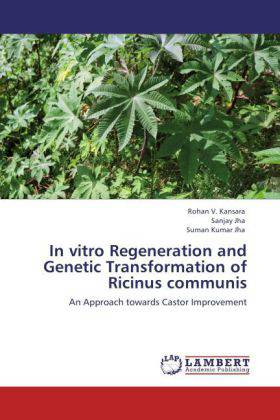
- Afhalen na 1 uur in een winkel met voorraad
- Gratis thuislevering in België vanaf € 30
- Ruim aanbod met 7 miljoen producten
- Afhalen na 1 uur in een winkel met voorraad
- Gratis thuislevering in België vanaf € 30
- Ruim aanbod met 7 miljoen producten
Zoeken
In Vitro Regeneration and Genetic Transformation of Ricinus Communis
An Approach towards Castor Improvement
Rohan V Kansara, Sanjay Jha, Suman Kumar Jha
Paperback | Engels
€ 58,45
+ 116 punten
Omschrijving
An efficient in vitro plant regeneration and Agrobacterium tumefaciens mediated genetic transformation protocol was described for castor (Ricinus communis L.) using meristem as explants. Shoot apex containing apical meristems were excised from 5-7 days old in vitro grown seedlings and cultured on Murashige and Skoog (MS) medium supplemented with different concentrations of cytokinins singly or in combination. Kinetin (0.50 mg/l) in combination with BAP (0.25 mg/l) produced maximum number of shoot (10.33) and shoot length (5.20 cm). For root induction, in vitro produced shoots were transferred to rooting media containing 1/2 MS basal media with NAA. In Agrobacterium tumefaciens mediated genetic transformation, Agrobacterium tumefaciens strain containing construct pBIN1F harboring nptII and cry1F gene was used. The integration of the gene was confirmed by using PCR. The transformation experiment was performed by optimizing age of the seedlings and co-cultivation duration with Agrobacterium. When the effect of the age of the seedlings and co-cultivation duration evaluated fifteen days old seedlings and co-cultivated for three days yielded the frequency of transformation 2%.
Specificaties
Betrokkenen
- Auteur(s):
- Uitgeverij:
Inhoud
- Aantal bladzijden:
- 128
- Taal:
- Engels
Eigenschappen
- Productcode (EAN):
- 9783847374268
- Verschijningsdatum:
- 23/01/2012
- Uitvoering:
- Paperback
- Formaat:
- Trade paperback (VS)
- Afmetingen:
- 152 mm x 229 mm
- Gewicht:
- 199 g

Alleen bij Standaard Boekhandel
+ 116 punten op je klantenkaart van Standaard Boekhandel
Beoordelingen
We publiceren alleen reviews die voldoen aan de voorwaarden voor reviews. Bekijk onze voorwaarden voor reviews.











